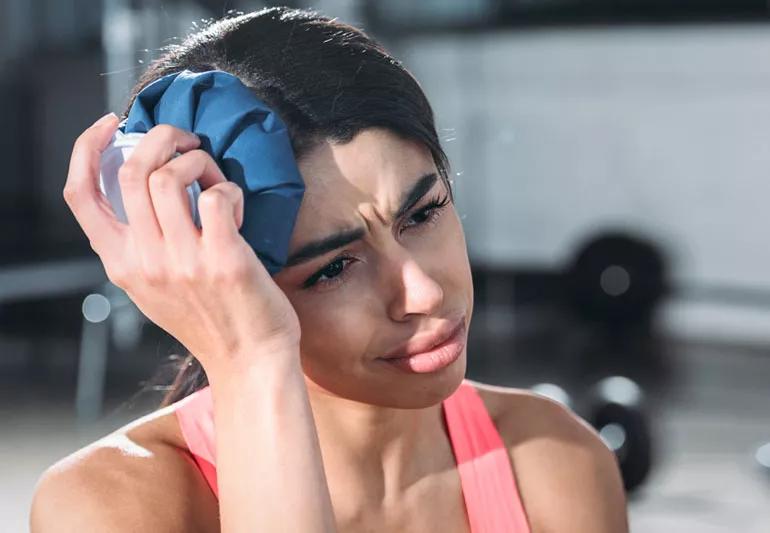Repeated trauma over time can have a cumulative effect

Scenario one: You’re playing ball, get beaned in the head and start to feel nauseous and dizzy. Uh-oh. You know there’s a possibility of a concussion, so you go to your nearest emergency room.
Advertisement
Cleveland Clinic is a non-profit academic medical center. Advertising on our site helps support our mission. We do not endorse non-Cleveland Clinic products or services. Policy
Scenario two: Same ballgame, same beaning, but you feel fine. No need to worry or see a doctor, right?
Well, you may want to reconsider. In this Q&A, concussion expert Richard Figler, MD, discusses these minor head injuries, called subconcussive hits, and their impact on the brain.
A: A concussion happens when you get hit in the head hard enough to cause a transient disturbance of brain function or causes your brain not to function normally. You experience symptoms ranging from headache, dizziness or nausea to feeling confused or out of it. A “mild” concussion is one that is not life-threatening but typically requires a doctor’s care.
So if you took a small hit to the head and had any concussion symptoms, you should leave the activity right away. You should then have a doctor examine you to rule out a concussion. (We would consider it a concussion until proven otherwise.)
A subconcussive blow is one rung below a mild concussion. You get hit in the head but you don’t experience symptoms. In this case, we would not suspect a concussion (but symptoms can come on hours after hit, so monitor closely). However, this minor blow may still cause damage over time. We would be naïve to think there’s not some force that’s transmitted to the brain from these milder hits. We simply don’t know enough about these milder hits to definitively say how dangerous they are.
Advertisement
A: There have been studies on accelerometers (a device which measures acceleration) and helmets, but the data is difficult to interpret because:
I’ve had situations where athletes — who often sustain blows to their heads — have gotten concussions from a small unexpected hit on the back of the head. While soccer and football players often develop neck strength that may absorb smaller blows, if they receive a hit they’re not ready for, they can be out for two or more weeks with a concussion because they never had time to prepare for that unexpected hit.
A: While the younger brain may heal faster, we also know that the developing brain in younger people is probably more irritated by subtle blows to the head. As athletes get older, we think the brain can withstand a little more force.
Plus, younger people may not report concussion symptoms because they don’t know they’re having them. Children are notorious for not being able to explain what a headache is or exactly how they’re feeling. So we can’t definitively say that the younger athlete can sustain these minor blows without any significant repercussions.
The takeaway is we need to protect younger athletes:
A: You should visit an emergency room if you experience serious symptoms, such as:
Follow up with your doctor about hits to the head that cause both major and minor concussion symptoms. More minor symptoms include:
Advertisement
But pay attention to anything that would make someone stop play and not be able to continue for even a short time. The motto is “When in doubt, sit them out.” Remember: It’s safer to err on the side of caution. Even if you don’t experience concussion symptoms, call your doctor if you have any concerns following a subconcussive impact.
Physician visits are especially important for athletes that sustained concussions because we need to ensure their health before they return to play. We can work with them on symptom reduction faster than they could on their own. We also offer guidelines about how to:
And we emphasize concussion education. We help you recognize the signs of a concussion so you can pull yourself out of play sooner. You’ll recover faster than someone who stays in the game with concussion symptoms.
Advertisement
Learn more about our editorial process.
Advertisement

Watch for severe symptoms in older kids and adults, but kids under age 2 should always see a provider

Physical activity can help preserve and improve your cognitive function and fend off dementia, stroke and other health concerns

Lower-intensity workouts can deliver high-quality health and fitness results

Incremental changes in your exercise routine can improve your strength and endurance over time

Understanding heart rate zones can help you tailor your workout to reach your goals

Increase the size of your muscles by bulking up on protein and focusing on slow, intense movements with progressive overloading

Low-impact exercises help you recover faster between sets, during cool downs and on rest days

Try seated and standing exercises to help lengthen and strengthen the muscles that support your plantar fascia

Babies can get congested easily, but you can calm their cough by keeping them hydrated, using nasal drops and running a humidifier

Weight loss may cause loose, sagging skin and muscle loss to your rear

Several conditions, like vitiligo and fungal infection, can cause a loss of pigmentation, leading to white spots or patches on your skin